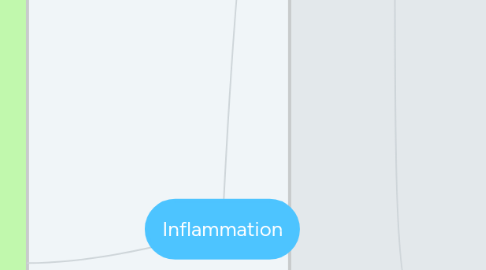
1. Chronic
1.1. characterized
1.1.1. lymphocytes
1.1.1.1. activation
1.1.1.1.1. binding antigen/MHC complex
1.1.1.1.2. 2nd signal
1.1.1.2. T
1.1.1.2.1. TCR complex recognizes antigen presented on MHC
1.1.1.3. B
1.1.1.3.1. activation
1.1.2. plasma cell in tissue
1.2. delayed response
1.2.1. adaptive immunity
1.3. stimuli include
1.3.1. persistent infection
1.3.1.1. viruse
1.3.1.2. mycobacteria
1.3.1.3. parasites
1.3.1.4. fungi
1.3.2. autoimmune disease
1.3.3. foreign material
1.3.4. some cancers
1.4. Granulomatous Inflammation
1.4.1. subtype of chronic
1.4.2. characterized
1.4.2.1. granuloma
1.4.2.1.1. collection of epithelioid histiocytes
1.4.2.1.2. surrounded by giant celles
1.4.2.1.3. a rim of lymphocytes
1.4.3. formation
1.4.3.1. macrophages secrete IL-12
1.4.3.1.1. CD4+ differentiate into Th1
1.4.4. noncaseating
1.4.4.1. lake central necrosis
1.4.4.2. common etiologies
1.4.4.2.1. foreign material
1.4.4.2.2. sarcoidosis
1.4.4.2.3. beryllium exposure
1.4.4.2.4. Crohn disease
1.4.4.2.5. cat scratch disease
1.4.5. caseating
1.4.5.1. cental necrosis
1.4.5.2. common etiologies
1.4.5.2.1. tuberculosis
1.4.5.2.2. fulgal infections
2. Acute
2.1. Cardinal Signs
2.1.1. Redness (rubor) and warmth (calor)
2.1.1.1. Vasodilation
2.1.1.1.1. histamine
2.1.1.1.2. prostaglandins
2.1.1.1.3. bradykinin
2.1.2. Swelling (tumor)
2.1.2.1. exudate (postcapillary venules)
2.1.2.1.1. histamine
2.1.2.1.2. tissue damage
2.1.3. Pain (dolor)
2.1.3.1. bradykinin
2.1.3.2. PGE2
2.1.4. Fever
2.1.4.1. pyrogens
2.1.4.1.1. ex. LPS from bacteria
2.1.4.1.2. macrophages release IL-1, TNF
2.2. Mediators
2.2.1. Toll-like receptors (TLRs)
2.2.1.1. present on cells of the innate and adaptive system
2.2.1.2. activated by PAMPS/DAMPS
2.2.1.2.1. CD14 on macrophages recognizes LPS on gram-negative
2.2.1.3. activetes results in upregulation of NF-kB
2.2.2. Arachidonic acid (AA) metabolites
2.2.2.1. released from the phospholipid cell membrane by phospholipase
2.2.2.1.1. cyclooxygenase (COX)
2.2.2.1.2. 5-lipooxygenase
2.2.3. Mast cells
2.2.3.1. distributed throughout connective tissue
2.2.3.2. activated
2.2.3.2.1. tissue trauma
2.2.3.2.2. C3a and C5a
2.2.3.2.3. cross-linking of cell-surface IgE by antigen
2.2.3.2.4. response
2.2.4. Complement
2.2.4.1. activation
2.2.4.1.1. classical
2.2.4.1.2. alternative
2.2.4.1.3. mannose-binding lectin (MBL)
2.2.4.2. Function
2.2.4.2.1. C5a
2.2.4.2.2. C3b
2.2.4.2.3. MAC
2.2.5. Hageman factor (Factor XII)
2.2.5.1. Activated upon exposure to subendothelial or tissue collagen
2.2.5.1.1. coagulation and fibrinolytic systems
2.2.5.1.2. complement
2.2.5.1.3. kinin system
2.3. Characterized
2.3.1. Edema
2.3.2. innate cells
2.3.2.1. neutrophil
2.3.2.1.1. function
2.3.2.1.2. arrival
2.3.2.2. macrophages
2.3.2.2.1. arrival 2-3 days after infl. begins
2.3.2.2.2. phagocytosis
2.3.2.2.3. manage the next step of the inflammatory process
